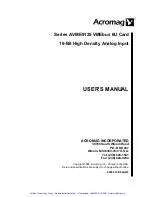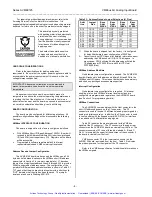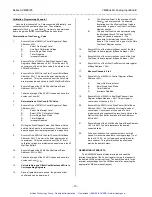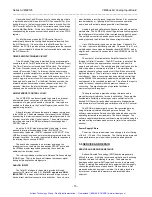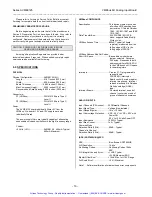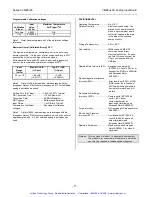
Series AVME9125 VMEbus 6U Analog Input Board
- 2 -
The information contained in this manual is subject to change
without notice. Acromag, Inc. makes no warranty of any kind with
regard to this material, including, but not limited to, the implied
warranties of merchantability and fitness for a particular purpose.
Further, Acromag, Inc. assumes no responsibility for any errors
that may appear in this manual and makes no commitment to
update, or keep current, the information contained in this manual.
No part of this manual may be copied or reproduced in any form,
without the prior written consent of Acromag, Inc.
Table of Contents
Page
1.0 GENERAL INFORMATION
...........................................
2
KEY FEATURES.........................……………………......
2
VMEbus INTERFACE FEATURES................................
3
2.0 PREPARATION FOR USE
............................................
3
UNPACKING AND INSPECTION..................................
3
CARD CAGE CONSIDERATIONS................................
4
BOARD CONFIGURATION...........................................
4
VMEbus INTERFACE CONFIGURATION.....................
4
Address Decode Jumper Configuration.....................
4
VMEbus Address Modifiers.......................................
4
Interrupt Configuration...............................................
4
VMEbus Connections................................................
4
POWER-UP TIMING AND LOADING............................
5
DATA TRANSFER TIMING...........................................
6
FIELD GROUNDING CONSIDERATIONS....................
6
3.0
PROGRAMMING INFORMATION
.................................
6
MEMORY MAPS...........................................................
6
Card Identification Space..........................................
7
Board Status Register………….................................
7
Control Register……………..….................................
7
Analog Input Range & Corresponding Output Code..
8
Interrupt Vector Register...........................................
8
Timer Prescaler Register...........................................
8
Conversion Timer Register.............….......................
8
Start Channel Value Registers……………….............
9
End Channel Value Register.....................................
9
New Data Registers................…………….................
9
Missed Data Registers…...........................................
9
Start Convert Registers…..........…............................
9
Offset Coefficient Registers…...................................
10
Gain Coefficient Registers….....................................
10
Mail Box Buffer……………..…...................................
11
MODES OF OPERATION.............................................
11
Uniform Continuous-Mode.........................................
11
Uniform Single-Mode.................................................
11
Burst Continuous-Mode.............................................
11
Burst Single-Mode.....................................................
12
PROGRAMMING CONSIDERATIONS..........................
12
Use of Calibration Signals.........................................
12
Uncalibrated Performance.........................................
12
Calibrated Performance….........................................
12
Calibration Programming Example 1.........................
13
GENERATING INTERRUPTS.......................................
13
Interrupt Configuration Example...............................
14
Sequence of Events for an Interrupt.........................
14
4.0
THEORY OF OPERATION
...........................................
14
AVME9125 BOARD OVERVIEW..................................
14
VMEbus Interface......................................................
14
Board Registers and Control Logic............................
14
INTERNAL CHANNEL POINTERS................................
14
TIMED PERIODIC TRIGGER CIRCUIT.........................
15
VME INTERRUPT CONTROL LOGIC...........................
15
ANALOG INPUTS…………………….............................
15
Power Supply Filters......……........................................
15
5.0
SERVICE AND REPAIR
................................................
15
SERVICE AND REPAIR ASSISTANCE....................….
15
PRELIMINARY SERVICE PROCEDURE......................
16
6.0
SPECIFICATIONS
........................................................
16
PHSICAL……………………….......................................
16
VMEbus COMPLIANCE............................................….
16
ANALOG INPUTS……..................................................
16
ENVIRONMENTAL……………......................................
17
DRAWINGS
Page
4501-678 AVME9125 BLOCK DIAGRAM...…….…......
18
4501-679 AVME9125 JUMPER LOCATIONS……..…..
19
4501-688 ANALOG INPUT CONNECTION……...........
20
IMPORTANT SAFETY CONSIDERATIONS
It is very important for the user to consider the possible adverse
effects of power, wiring, component, sensor, or software failures
in designing any type of control or monitoring system. This is
especially important where economic property loss or human life
is involved. It is important that the user employ satisfactory
overall system design. It is agreed between the Buyer and
Acromag, that this is the Buyer's responsibility.
1.0 GENERAL INFORMATION
The AVME9125 VMEbus card performs precision 16-bit
analog to digital conversions. The AVME9125 supports 16
channels of differential analog inputs. With the addition of the
companion card the EXP9125, up to 32 channels of differential
analog inputs can be selected for conversion.
The AVME9125 offers a variety of features which make it an
ideal choice for many industrial and scientific applications as
described below.
KEY AVME9125 FEATURES
•
Interface for 32 Differential Channels
- Provides an
electrical and mechanical interface for up to 32 Differential
Channels. 16 differential channels are individually input via
the P2 connector of the AVME9125 and the other 16
differential channels are multiplexed to a single differential
pair using a companion Expander Card (EXP9125).
•
A/D 16-Bit Resolution
- 16-bit capacitor-based successive
approximation Analog to Digital Converter (ADC) with integral
sample and hold and reference.
•
Real Time Correction -
Correction logic is provided along
with calibration autozero and autospan precision voltages to
permit real time hardware correction of conversion errors.
Trimmed calibration voltages include: 0V (local analog
ground), and 9.79V.
•
Diagnostic Capability
- Diagnostic capability using ground
and reference.
•
11.25
µ
sec Conversion Time
- A maximum conversion rate
of
≅
88KHz is supported.
Artisan Technology Group - Quality Instrumentation ... Guaranteed | (888) 88-SOURCE | www.artisantg.com


